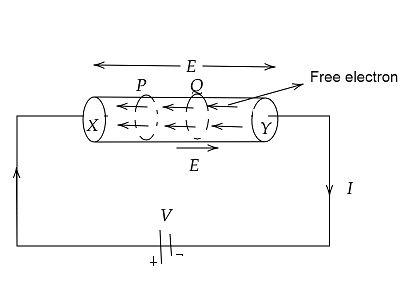
Establish a relation between electric current and drift velocity. OR prove that the current density of metallic conductors is directly proportional to the drift speed of electrons.
Answer
558.9k+ views
Hint Here, we know that the concept of electric current and drift velocity so that we can analyze the electron w velocity should understand that current density J is a vector quantity defined as the current flowing per unit area measured in a normal direction to the charge flow direction.
Useful formula:
Current density,
\[J = pv\]
Where,
$J$ is electric current density,
$p$ charge the velocity,
$v$ velocity of density,
Complete step by step procedure
Relation between electric current and drift velocity.
Consider a uniform metallic wire $XY$ of length $1$ and cross-sectional area $A$. A potential difference V is applied across the ends $X$ and $Y$ of the wire.
At each point of the force wire, this causes an electric field.
\[E = \dfrac{V}{l}........\left( i \right)\]
This causes an electric field at each point of the force wire,${V_d}$ The opposite of the electric field's direction.
Current in wire \[I = \dfrac{q}{t}..........\left( i \right)\]
The distance traversed by each electron in time \[t = average\,velocity\]$X$ time \[ = {V_d}t\]
The total charge flowing in time $t$is equal to the total charge on the electrons present within the cylinder if we consider two planes $P$ and $Q$ at a distance ${V_d}$ in a conductor.
The volume of this cylinder is equal to cross sectional area $X$ height
$A{V_d}t$
If $n$ The number of free electrons per unit volume in the wire is then equal to the number of free electrons in the cylinder to $nA{V_d}t$

then,
the total charge flowing through a cross section of the wire.
\[q = \left( {nA{V_d}t} \right)\left( { - e} \right) = - neA{V_d}t.........\left( {iii} \right)\]
Therefore,
Current flowing in the wire,
\[I = tq = t - v\]
\[\;currentI = - neA{V_d}.......\left( {iv} \right)\]
This is the relation between current and drift velocity. Negative sign shows that the direction of current is opposite to the drift velocity
\[Numericaly\;I = - neA\tau d...............\left( v \right)\]
Therefore, Current density,
\[J = \dfrac{l}{A}.\]
Rearranging the equation,
We get,
\[ \Rightarrow JAI = d\]
Here,
We get,
\[ \Rightarrow J\alpha D\]
Hence,
This is the metallic conductor's current density that is directly proportional to the drift velocity.
Note According to that a drift velocity is the average velocity obtained by charged particles in a medium due to an electrical field, such as electrons. In general, at Fermi velocity, an electron in a conductor will spread spontaneously, leading to an average velocity of zero.
Useful formula:
Current density,
\[J = pv\]
Where,
$J$ is electric current density,
$p$ charge the velocity,
$v$ velocity of density,
Complete step by step procedure
Relation between electric current and drift velocity.
Consider a uniform metallic wire $XY$ of length $1$ and cross-sectional area $A$. A potential difference V is applied across the ends $X$ and $Y$ of the wire.
At each point of the force wire, this causes an electric field.
\[E = \dfrac{V}{l}........\left( i \right)\]
This causes an electric field at each point of the force wire,${V_d}$ The opposite of the electric field's direction.
Current in wire \[I = \dfrac{q}{t}..........\left( i \right)\]
The distance traversed by each electron in time \[t = average\,velocity\]$X$ time \[ = {V_d}t\]
The total charge flowing in time $t$is equal to the total charge on the electrons present within the cylinder if we consider two planes $P$ and $Q$ at a distance ${V_d}$ in a conductor.
The volume of this cylinder is equal to cross sectional area $X$ height
$A{V_d}t$
If $n$ The number of free electrons per unit volume in the wire is then equal to the number of free electrons in the cylinder to $nA{V_d}t$

then,
the total charge flowing through a cross section of the wire.
\[q = \left( {nA{V_d}t} \right)\left( { - e} \right) = - neA{V_d}t.........\left( {iii} \right)\]
Therefore,
Current flowing in the wire,
\[I = tq = t - v\]
\[\;currentI = - neA{V_d}.......\left( {iv} \right)\]
This is the relation between current and drift velocity. Negative sign shows that the direction of current is opposite to the drift velocity
\[Numericaly\;I = - neA\tau d...............\left( v \right)\]
Therefore, Current density,
\[J = \dfrac{l}{A}.\]
Rearranging the equation,
We get,
\[ \Rightarrow JAI = d\]
Here,
We get,
\[ \Rightarrow J\alpha D\]
Hence,
This is the metallic conductor's current density that is directly proportional to the drift velocity.
Note According to that a drift velocity is the average velocity obtained by charged particles in a medium due to an electrical field, such as electrons. In general, at Fermi velocity, an electron in a conductor will spread spontaneously, leading to an average velocity of zero.
Recently Updated Pages
A man running at a speed 5 ms is viewed in the side class 12 physics CBSE

State and explain Hardy Weinbergs Principle class 12 biology CBSE

Which of the following statements is wrong a Amnion class 12 biology CBSE

Two Planoconcave lenses 1 and 2 of glass of refractive class 12 physics CBSE

The compound 2 methyl 2 butene on reaction with NaIO4 class 12 chemistry CBSE

Bacterial cell wall is made up of A Cellulose B Hemicellulose class 12 biology CBSE

Trending doubts
What are the major means of transport Explain each class 12 social science CBSE

Which are the Top 10 Largest Countries of the World?

Draw a labelled sketch of the human eye class 12 physics CBSE

Explain sex determination in humans with line diag class 12 biology CBSE

Give 10 examples of unisexual and bisexual flowers

State the principle of an ac generator and explain class 12 physics CBSE




